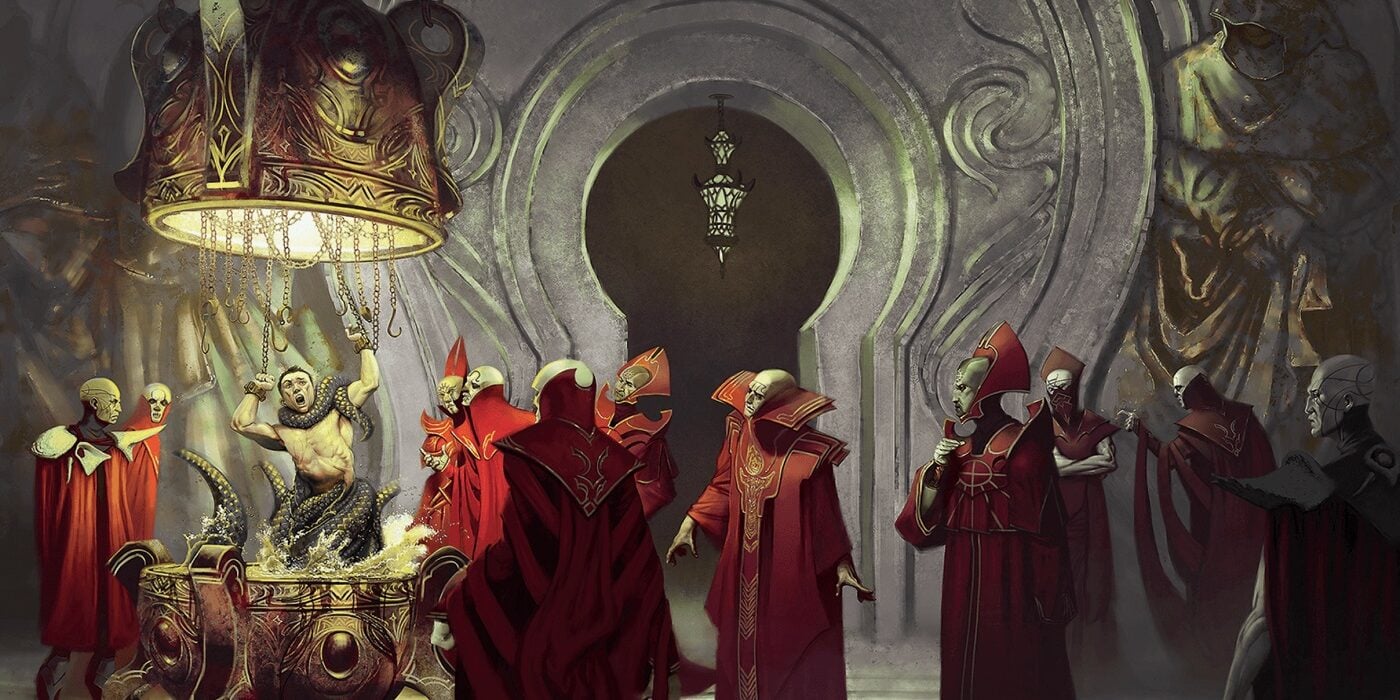Want your villains to feel like they know what they’re doing? Here are five tips to make them feel like a slithering organization of evil.
If you want your villains to feel like the sort of “plan for everything” type, you have your work cut out for you. Players can be unpredictable with their ideas. And worse, they may not even pay attention to the subtle clues you lay out to what your villains are trying to do. That can undermine a mastermind villain—or a villainous organization.
But if you want your bad guys to feel organized or to have the semblance of competence, you don’t actually have to work that hard. Here are a few useful tricks you can use to make it seem like your villains know what they’re doing.
Branding

In some ways, it’s all about visibility. This may run counter to your idea that a villainous organization might try to keep their activities hidden. But for the sake of the narrative, it helps if your secret schemes are done by people wearing a very identifiable uniform.
The right branding is a cue to the players that here’s another part of a larger whole. And plus, a good visual theme is just fun to describe. Whether it’s something like the Red Wizards’ eponymous robes. Or the Order of the Emerald Claw’s sigil. If you pick a visual cue and repeat it over and over with enemies associated with your villain? Your player characters will catch on, and this can lead to moments of “oh! an emerald claw! like those other ones we fought!” And then you’re well on your way to making it seem like the villains are organized enough to have a wide reaching footprint.
Epistolary Cues—AKA Fantasy Audio Logs and Notes

This is one I like to steal from video games. While it might not make sense for every villain or henchman or whatever that your PCs defeat to have a book that says “HOW I DID IT AND WHAT I PLAN TO DO NEXT” on them, it can be helpful to give context via diegetic communications within the world.
In other words, fantasy audio logs. Which can be actual audio things—PCs could find magic recording crystals or whatever, or could just be very detailed notes, or journals, or my favorite, a written down order to a minion, specifying what they need to do. You don’t have to say why—that can often be good to leave to the players.
Trust me, they will take it and run with it in places you might no have expected. All you have to do is leave a little note that says “remember, steal only RED GEMS” or “on the night of the eclipse, three sacrifices in the north nodes” or whatever. Leave it to the players to figure out what exactly that means (or come up with something later, if you don’t have a clue).
Consistency

Consistency is a great way to make it seem like someone knows what they’re doing. Even if your players keep pounding them into the dirt, if they keep running into the Emerald Claw’s assassins, they know they’re on the right track. Whoever is trying to fight you is kind of a signifier of who your party’s actions are upsetting.
So running into the same villains (which is where branding comes in handy) again and again, makes it feel like you’re making progress at stopping whatever it is they plan on doing.
Foreshadowing, Fiveshadowing, Heck, Why Not Some Sixshadowing Even

This is another rule to borrow from other media—you can’t always trust that your audience (in this case your players) are paying attention. Or have clocked that something is important to the plot. That’s why it can be helpful to make sure you repeat the information (not necessarily the exact same way) but that you have multiple ways to deliver the same clue.
Why would you want to do this? When the players think they know what a villain is up to—it makes it feel like the bad guys are organized enough to have their own plan. Even if you have only planned as far as “and then they set the city hall on fire.”
Which you might foreshadow by having a letter (that has either not been sent, or was looted on a body) that says something like “the shipment of oil and torches was delivered, make sure to distract the city hall guards.” While an NPC in town might say something like “I saw a bunch of weird, oily barrels near city hall earlier today.” And still another example might be seeing a hastily sketched map of how to get away from the city. Repeat a thing until you hear from the players that they get it. But, you know, you gotta feel out when you’re getting too repetitive. It’s an art.
Find That Silver Lining

It is hard to make villains seem organized past a certain point. Because the expectation is that they’ll be beaten, eventually. And the way D&D goes, they’ll probably be beaten at every turn, unless you can pull it off real carefully.
But one thing you CAN do, that won’t rob the players of their agency or their victory, is to let them have their wins where they fall. And if you can, see if there’s something the villain might gain even in a loss. You see this a lot in superhero stories. The heroes save the townsfolk, but the bad guys got away with the magical gem. Or the heroes stopped the cultist’s ritual—and as a result there’s a power struggle among the Red Wizards. Or do like a devil’s bargain thing—where it’s like “the Lich lord offers to provide aid to the village in exchange for a temporary truce” and you know it’ll come with a cost later, but for now it’s a definite win.
Happy adventuring!
Don’t Miss:
Read more at this site
